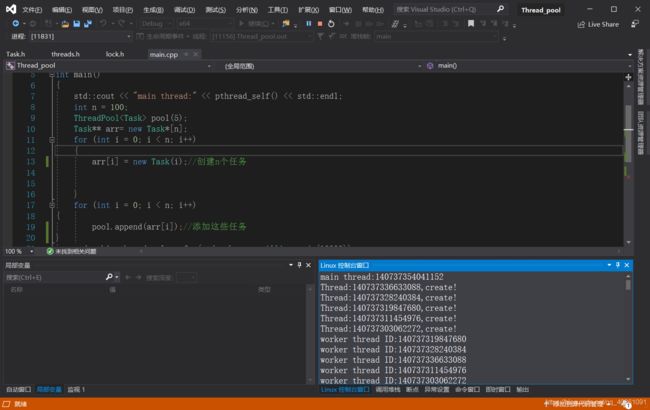- 深入解析C++中 std::sort背后的实现原理 —Introsort(Introspective Sort)
点云SLAM
C++c++算法数据结构快速排序排序算法堆排序深度优先
Introsort简介Introsort是一种混合排序算法,结合了三种经典算法的优点:算法用于特点快速排序通常情况平均时间复杂度O(nlogn)堆排序当快速排序退化(递归过深)时最坏时间复杂度O(nlogn)插入排序小规模数组时(如长度≤16)常数开销小,快Introsort运行机制排序逻辑如下:if(size2*log2(n))堆排序(HeapSort)else快速排序(QuickSort)快速
- error -- unsupported GNU version gcc later than 10 are not supported;(gcc、g++)
众人(某音、某书同名)
服务器linux运维
服务器跑dit时编译flash-atten以及pytorch的cuda版本检查出错,分别报错题目以及如下:想了下是系统找不到编译器subprocess.CalledProcessError:Command'['which','c++']'returnednon-zeroexitstatus1.备案,以后有人要用12我还得换回来方案一:更改gcc和gcc+的版本没有合适的版本的话需要root权限指定
- 【华为od刷题(C++)】HJ33 整数与IP地址间的转换
m0_64866459
华为odc++链表
我的代码:#include//这个头文件提供了输入输出流的功能,使得我们能够使用cin和cout来进行输入输出usingnamespacestd;//可以直接使用标准命名空间std中的功能//比如cout和cin,而不需要每次都写出std::intmain(){longlonginta,b,c,d;//a,b,c,d:这四个变量用来存储IP地址的四个部分//分别代表IP地址中的四个字节longlo
- 了解GC吗?什么是GC?
后端java
GC是什么?为什么要GC?GC(GarbageCollection),垃圾回收,是Java与C++的主要区别之一。作为Java开发者,一般不需要专门编写内存回收和垃圾清理代码。这是因为在Java虚拟机中,存在自动内存管理和垃圾清理机制。对JVM中的内存进行标记,并确定哪些内存需要回收,根据一定的回收策略,自动的回收内存,保证JVM中的内存空间,防止出现内存泄露和溢出问题。GC是任意时候都能进行的吗
- 《力扣》链表 | 19. 删除链表的倒数第 N 个结点 C++题解
一只一只
算法数据结构链表c++leetcode
19.删除链表的倒数第N个结点-力扣(LeetCode)给你一个链表,删除链表的倒数第n个结点,并且返回链表的头结点。示例1:输入:head=[1,2,3,4,5],n=2输出:[1,2,3,5]好神奇的解法,有股相对运动的赶脚双指针:a,b(同时指向头节点)1.先让a指针移动n个节点2.然后a,b一起移动,当a移动到末尾的时候,b就恰好移动到倒数第n个数也就是我们通过a指针限制b只能移动(len
- C++之利用红黑树作为底层,实现对set和map的封装(难)
模拟封装map和set一.回顾红黑树二.模拟实现map和set2.1复⽤红⿊树,实现insert结构体SetKeyOfT结构体MapKeyOfT2.2⽀持iterator的实现迭代器具体实现部分上层迭代器操作普通迭代器与const迭代器map与set红黑树1.前缀递增操作符`++`2.前缀递减操作符`--`示例前缀递增操作符`++`前缀递减操作符`--`2.3map操作符[]代码解析成员变量和函数
- 进程 ⇢ JVM ⇢ 线程 + 内存关系
MYGAG
jvm
.从零到跑起一个Java程序OS创建进程execvejava…→新进程的地址空间、handle、时间片就位。JavaLauncher进场可执行文件里的C/C++的main()解析参数,dlopenlibjvm.so/jvm.dll。JNI_CreateJavaVM诞生JVM实例△分配堆、元空间、代码缓存等△拉起GC/JIT/信号处理等守护线程把Launcher的原生线程变成Javamain线程开始
- 145、将程序划分为模块:深入理解C++中的模块化编程
raspberrypi5
C++编程入门与实践C++模块化编程头文件
将程序划分为模块:深入理解C++中的模块化编程1.模块化编程的意义在软件开发中,将大型程序划分为较小的模块是一种常见的实践。这种做法不仅提高了代码的可维护性和可读性,还便于团队协作。通过将功能分离到不同的模块中,开发者可以专注于特定的功能实现,而不必担心整个程序的复杂性。此外,模块化编程还有助于代码的重用,减少了冗余代码的编写。优点总结减少编译时间:小模块可以更快地编译,特别是对于大型项目,整体编
- c++ python 共享内存
qianbo_insist
音视频和c++java物联网c++c++python开发语言
一、目的是为了c++来读取并解码传递给python,Python做测试非常方便,c++和python之间必须定好协议,整体使用c++来解码,共享内存传递给python二、主类主类,串联decoder,注意decoder并没有直接在显存里面穿透,是解码以后传递给内存,从内存传给python#pragmaonce#define__STDC_CONSTANT_MACROS#defineSDL_MAIN_
- 模块三:现代C++工程实践(4篇)第一篇《C++模块化开发:从Header-only到CMake模块化》
AI迅剑
c++开发语言cmake
引言:现代C++工程化的核心挑战(终极扩展版)在云计算与物联网时代,C++项目规模呈指数级增长。传统Header-only开发模式暴露出编译效率低下、依赖管理混乱、版本冲突频发等致命问题。本文通过CMake3.22+Conan2.0工具链的深度集成,结合5个真实工业案例和200+行配置代码,系统阐述:Header-only库的模块化改造(含性能数据、内存分析)CMake高级配置技巧(目标属性、接口
- 【C++ 内存管理】静态分配和动态分配
【C++内存管理】静态分配和动态分配_静态分配内存和动态分配内存-CSDN博客1.静态分配定义:在编译阶段确定内存大小和生命周期,由编译器自动分配和释放。特点:①分配时机:程序启动时分配,程序结束时释放。②内存区域:数据段(全局变量或者静态变量)和栈区。③生命周期:与程序或模块的执行周期一致。④大小固定:内存大小在编译时已知,不可动态调整。⑤无需手动管理:由编译器自动释放。2.动态分配定义:在程序
- c++协程(Coroutines)-无限的整数序列
1.概要2.内容协程(Coroutines)是C++20引入的一种特性,它使得编写异步代码变得更加简单和直观。协程允许函数在执行过程中暂停并在稍后恢复,从而实现非阻塞的异步操作。以下是对C++协程的详细介绍:一、协程的基本概念协程是一种计算机程序组件,用于协同完成任务的子例程。它被视为轻量级线程,拥有自己的暂停点状态。协程可以在执行过程中暂停,将当前状态保存起来,并在稍后恢复执行时恢复之前保存的状
- 支持向量机(SVM)在肝脏CT/MRI图像分类(肝癌检测)中的应用及实现
猿享天开
医学影像支持向量机机器学习人工智能算法
博主简介:CSDN博客专家、CSDN平台优质创作者,高级开发工程师,数学专业,10年以上C/C++,C#,Java等多种编程语言开发经验,拥有高级工程师证书;擅长C/C++、C#等开发语言,熟悉Java常用开发技术,能熟练应用常用数据库SQLserver,Oracle,mysql,postgresql等进行开发应用,熟悉DICOM医学影像及DICOM协议,业余时间自学JavaScript,Vue,
- C++高级编程(7)-- 协程在C++中的应用
给你一颗语法糖
C++高级编程c++开发语言
协程在C++中的应用随着现代编程范式的发展,协程(Coroutines)已经成为了并发编程和异步编程的一个重要工具。在C++中,协程是一种能够被挂起和重新恢复执行的函数,它允许程序员以一种更加直观和简洁的方式来编写异步代码。本篇博客将深入探讨C++中的协程概念、实现原理以及高级应用案例,帮助读者更好地理解和应用这一强大的编程技术。协程基础在C++20标准中,协程是通过关键字co_await,co_
- 简述C++ nlohmann/json 库
ikkkkkkkl
jsonc++nlohmann
目录JSON概述nlohmann/json库的使用创建json数组/对象字符串解析(parse反序列化)数据访问序列化文件读写JSON概述JSON(JavaScripObjectNotation)是一种轻量级、跨语言的数据交换格式。它基于ECMAScript子集,以独立于编程语言的文本格式存储和表示数据,简洁清晰的结构使其成为理想的数据交换语言,易读、易写且便于机器解析生成,能提升网络传输效率。J
- C++中noexcept的具体特性及其代码示例
码事漫谈
c++c++开发语言
文章目录1.**作为异常说明符**2.**作为运算符**3.**性能优化**4.**异常安全性**总结1.作为异常说明符noexcept可以放在函数声明或定义的后面,表示该函数不会抛出任何异常。如果函数在运行时抛出异常,程序会立即终止,并调用std::terminate()函数。特性:编译时检查:编译器会检查函数是否可能抛出异常。如果函数内部调用了可能抛出异常的代码,编译器会报错。运行时终止:如果
- 现代 C++ 容器深度解析及实践
mxpan
c++c++开发语言
一、线性容器:std::array与std::forward_list1.std::array:固定大小的高效容器在传统C++中,数组与vector的抉择常让人纠结:数组缺乏安全检查,vector存在动态扩容开销。C++11引入的std::array完美平衡了两者优势:特性解析:编译期确定大小,内存连续分配,访问效率与C数组一致;封装了迭代器、size()、empty()等标准接口,兼容STL算法
- C++从入门到放弃
一家之主呆呆蟹
C++c++
C++学习笔记--目录C++学习笔记1.C++命名空间2.继承与多态3.函数重载4.引用5.构造函数与析构函数6.初始化列表7.explicit关键字8.static静态成员和友元函数与友元类、内部类9.模板10.string11.vector12.List13.vector和list的区别及使用场景14.deque15.stack16.queue17.priority_queue18.set|m
- C++从入门到放弃--5.scanf()和printf()
目录5.1回顾cin和cout5.2printf()5.2.1printf()和scanf()5.2.1.1I/O的优缺点5.2.1.2操作5.2.1.3其他5.3scanf()Hello~下午好啊,告诉你们个事情:今天?更开始吧~(长文预警!!!)5.1回顾cin和cout前四章节,我们都对cin和cout有或多或少的了解,我们来回顾一下。cout是一个ostream类对象,cin是一个istr
- 『 C++入門到放棄 』 - vector 容器
逐花归海.
c++数据结构开发语言笔记
一、什麼是vectorvector是C++提供的一個容器(container),其底層邏輯類似於順序表二、vector接口(1)宣告&初始化std::vectorv;//空vectorstd::vectorv(5);//初始化為5個0(不給值默認為0)std::vectorv(5,10);//初始化為5個10std::vectorv={1,2,3};//使用初始化列表(2)基本操作v.push_b
- 『 C++入門到放棄 』- string
逐花归海.
c++程序人生开发语言c语言
C++學習筆記-string一、什麼是string?string是C++中標準函數庫中的一個類,其包含在中該類封裝了C語言中字符串操作,提供內存管理自動化與更多的操作支持複製、比較、插入、刪除、查找等功能二、常用接口整理類別常用方法/說明建立與指定std::strings="hello";長度s.size()、s.length()存取s[0]、s.at(0)(有邊界檢查)新增s.push_back
- vscode C++环境配置(供自己查阅)
想要躺平的一枚
VSCODEvscode
目录前言一、配置文件1、.vscode(1)c_cpp_properties.json(2)tasks.json(3)launch.json(4)settings.json参考链接:link前言 vscode可以当成一种强大的编辑器,只能够写代码(像VS这种IDE是集成编辑器、编译器,调试等等所有环境一起)。想要运行代码,还需要配置编译器,C++常用的编译器为MinGW,下载后将其配置到系统环境
- VScode 里面使用 python 去直接调用 CUDA
NeRF_er
pythonvscodepytorch
上一个帖子主要分享了如何去将C++程序打包成一个package。我们最后的目的实际上是想把CUDA的程序打包成一个Package,C++程序只是起到了桥梁的作用:首先:CUDA程序和C++的程序一样,都有一个.cu的源文件和一个.h的头文件。我们的文件包含Cpp文件组成,负责当作CUDA和Python的桥梁。还有对应的CUDA的源代码文件和头文件。将这个cpp文件命名成ext.cpp.#inclu
- 安装qt-sdk
Qt是一个跨平台的C++图形用户界面应用程序框架。Qt是完全面向对象的,很容易扩展,并且允许真正地组件编程。QtCreator是Qt被Nokia收购后推出的一款新的轻量级集成开发环境(IDE)。QTSDK包括了Qt库、QtCreatorIDE和Qt工具。QTCreator和QTSDK是需要分别单独安装的~在之前(这里:http://blog.csdn.net/arackethis/article/
- 【RTSP从零实践】4、使用RTP协议封装并传输AAC
博客主页:https://blog.csdn.net/wkd_007博客内容:嵌入式开发、Linux、C语言、C++、数据结构、音视频本文内容:介绍怎么使用RTP协议封装并传输AAC金句分享:你不能选择最好的,但最好的会来选择你——泰戈尔⏰发布时间⏰:2025-07-0118:43:18本文未经允许,不得转发!!!目录一、概述二、实现步骤、实现细节✨2.1、实现AAC文件读取器✨2.2、实现AAC
- 【归纳】C++入门算法模版总结(超级详细!!!)(包括高精度,排序,枚举,二分,搜索,动态规划等)
0.前言本文针对有一定算法基础的选手制作,收录了大部分算法的模板,详细解说可以点进去我提供的链接了解。或者进入我的主页给一点支持!本人也是一名新手,如果这篇文章有不严谨的地方或者不懂的地方可以在评论区留言,我会为你们一一解答的。【归纳】C++入门算法模版总结(包括高精度,排序,枚举,二分,搜索,动态规划等)(超级详细!!!)0.前言1.高精度1.1.单独实现1.1.1.高精度加法1.1.2.高精度
- (C++)学生管理系统(正式版)(map数组的应用)(string应用)(引用)(文件储存的应用)(C++教学)(C++项目)
目录源代码:代码详解:学生成绩管理系统实现详解一、系统整体设计思路1.数据结构选择2.功能模块划分二、关键函数实现原理1.文件存储与加载save_file函数load_file函数2.核心数据操作add函数mod函数find和del函数3.数据展示display函数statistics函数三、核心技术详解1.字符串分割技术2.map的使用技巧3.文件格式设计4.错误处理机制源代码:/**头文件部分
- 【基础】C++中的关键词
小熊猫爱编程
重新学编程c++开发语言
一、关键词的概念C++中的关键词是语言保留用来表示特定语法结构的单词,不能作为变量名、函数名或标识符使用。二、关键词有哪些在C++中有63个关键字,如下:关键词关键词关键词关键词关键词asmdoifreturntypedefautodoubleinlineshorttypeidbooldynamic_castintsignedtypenamebreakelselongsizeofunioncase
- 取余和取模到底是不是一回事?对比Python、Java、C和C++中的%运算符
霜叶桑
javapythonc语言c++
取余和取模到底是不是一回事?对比Python、JAVA、C和C++中的%运算符数学中的「取余」和「取模」计算机领域中的「取余」和「取模」Python、Java、C和C++中的`%`运算符Python:取模运算Java:取余运算C和C++:取余运算为什么一般用正除数数学中的「取余」和「取模」在纯数学中,当我们谈论整数除法a÷ba\divba÷b(aaa是被除数,bbb是除数,且b≠0b\not=0
- LeetCode-5.最长回文子串 C++实现
一.问题描述给你一个字符串s,找到s中最长的回文子串(如果字符串向前和向后读都相同,则它满足回文性。)。示例1:输入:s="babad"输出:"bab"解释:"aba"同样是符合题意的答案。示例2:输入:s="cbbd"输出:"bb"提示:1usingnamespacestd;classSolution{public:stringlongestPalindrome(strings){intn=s.
- Algorithm
香水浓
javaAlgorithm
冒泡排序
public static void sort(Integer[] param) {
for (int i = param.length - 1; i > 0; i--) {
for (int j = 0; j < i; j++) {
int current = param[j];
int next = param[j + 1];
- mongoDB 复杂查询表达式
开窍的石头
mongodb
1:count
Pg: db.user.find().count();
统计多少条数据
2:不等于$ne
Pg: db.user.find({_id:{$ne:3}},{name:1,sex:1,_id:0});
查询id不等于3的数据。
3:大于$gt $gte(大于等于)
&n
- Jboss Java heap space异常解决方法, jboss OutOfMemoryError : PermGen space
0624chenhong
jvmjboss
转自
http://blog.csdn.net/zou274/article/details/5552630
解决办法:
window->preferences->java->installed jres->edit jre
把default vm arguments 的参数设为-Xms64m -Xmx512m
----------------
- 文件上传 下载 解析 相对路径
不懂事的小屁孩
文件上传
有点坑吧,弄这么一个简单的东西弄了一天多,身边还有大神指导着,网上各种百度着。
下面总结一下遇到的问题:
文件上传,在页面上传的时候,不要想着去操作绝对路径,浏览器会对客户端的信息进行保护,避免用户信息收到攻击。
在上传图片,或者文件时,使用form表单来操作。
前台通过form表单传输一个流到后台,而不是ajax传递参数到后台,代码如下:
<form action=&
- 怎么实现qq空间批量点赞
换个号韩国红果果
qq
纯粹为了好玩!!
逻辑很简单
1 打开浏览器console;输入以下代码。
先上添加赞的代码
var tools={};
//添加所有赞
function init(){
document.body.scrollTop=10000;
setTimeout(function(){document.body.scrollTop=0;},2000);//加
- 判断是否为中文
灵静志远
中文
方法一:
public class Zhidao {
public static void main(String args[]) {
String s = "sdf灭礌 kjl d{';\fdsjlk是";
int n=0;
for(int i=0; i<s.length(); i++) {
n = (int)s.charAt(i);
if((
- 一个电话面试后总结
a-john
面试
今天,接了一个电话面试,对于还是初学者的我来说,紧张了半天。
面试的问题分了层次,对于一类问题,由简到难。自己觉得回答不好的地方作了一下总结:
在谈到集合类的时候,举几个常用的集合类,想都没想,直接说了list,map。
然后对list和map分别举几个类型:
list方面:ArrayList,LinkedList。在谈到他们的区别时,愣住了
- MSSQL中Escape转义的使用
aijuans
MSSQL
IF OBJECT_ID('tempdb..#ABC') is not null
drop table tempdb..#ABC
create table #ABC
(
PATHNAME NVARCHAR(50)
)
insert into #ABC
SELECT N'/ABCDEFGHI'
UNION ALL SELECT N'/ABCDGAFGASASSDFA'
UNION ALL
- 一个简单的存储过程
asialee
mysql存储过程构造数据批量插入
今天要批量的生成一批测试数据,其中中间有部分数据是变化的,本来想写个程序来生成的,后来想到存储过程就可以搞定,所以随手写了一个,记录在此:
DELIMITER $$
DROP PROCEDURE IF EXISTS inse
- annot convert from HomeFragment_1 to Fragment
百合不是茶
android导包错误
创建了几个类继承Fragment, 需要将创建的类存储在ArrayList<Fragment>中; 出现不能将new 出来的对象放到队列中,原因很简单;
创建类时引入包是:import android.app.Fragment;
创建队列和对象时使用的包是:import android.support.v4.ap
- Weblogic10两种修改端口的方法
bijian1013
weblogic端口号配置管理config.xml
一.进入控制台进行修改 1.进入控制台: http://127.0.0.1:7001/console 2.展开左边树菜单 域结构->环境->服务器-->点击AdminServer(管理) &
- mysql 操作指令
征客丶
mysql
一、连接mysql
进入 mysql 的安装目录;
$ bin/mysql -p [host IP 如果是登录本地的mysql 可以不写 -p 直接 -u] -u [userName] -p
输入密码,回车,接连;
二、权限操作[如果你很了解mysql数据库后,你可以直接去修改系统表,然后用 mysql> flush privileges; 指令让权限生效]
1、赋权
mys
- 【Hive一】Hive入门
bit1129
hive
Hive安装与配置
Hive的运行需要依赖于Hadoop,因此需要首先安装Hadoop2.5.2,并且Hive的启动前需要首先启动Hadoop。
Hive安装和配置的步骤
1. 从如下地址下载Hive0.14.0
http://mirror.bit.edu.cn/apache/hive/
2.解压hive,在系统变
- ajax 三种提交请求的方法
BlueSkator
Ajaxjqery
1、ajax 提交请求
$.ajax({
type:"post",
url : "${ctx}/front/Hotel/getAllHotelByAjax.do",
dataType : "json",
success : function(result) {
try {
for(v
- mongodb开发环境下的搭建入门
braveCS
运维
linux下安装mongodb
1)官网下载mongodb-linux-x86_64-rhel62-3.0.4.gz
2)linux 解压
gzip -d mongodb-linux-x86_64-rhel62-3.0.4.gz;
mv mongodb-linux-x86_64-rhel62-3.0.4 mongodb-linux-x86_64-rhel62-
- 编程之美-最短摘要的生成
bylijinnan
java数据结构算法编程之美
import java.util.HashMap;
import java.util.Map;
import java.util.Map.Entry;
public class ShortestAbstract {
/**
* 编程之美 最短摘要的生成
* 扫描过程始终保持一个[pBegin,pEnd]的range,初始化确保[pBegin,pEnd]的ran
- json数据解析及typeof
chengxuyuancsdn
jstypeofjson解析
// json格式
var people='{"authors": [{"firstName": "AAA","lastName": "BBB"},'
+' {"firstName": "CCC&
- 流程系统设计的层次和目标
comsci
设计模式数据结构sql框架脚本
流程系统设计的层次和目标
- RMAN List和report 命令
daizj
oraclelistreportrman
LIST 命令
使用RMAN LIST 命令显示有关资料档案库中记录的备份集、代理副本和映像副本的
信息。使用此命令可列出:
• RMAN 资料档案库中状态不是AVAILABLE 的备份和副本
• 可用的且可以用于还原操作的数据文件备份和副本
• 备份集和副本,其中包含指定数据文件列表或指定表空间的备份
• 包含指定名称或范围的所有归档日志备份的备份集和副本
• 由标记、完成时间、可
- 二叉树:红黑树
dieslrae
二叉树
红黑树是一种自平衡的二叉树,它的查找,插入,删除操作时间复杂度皆为O(logN),不会出现普通二叉搜索树在最差情况时时间复杂度会变为O(N)的问题.
红黑树必须遵循红黑规则,规则如下
1、每个节点不是红就是黑。 2、根总是黑的 &
- C语言homework3,7个小题目的代码
dcj3sjt126com
c
1、打印100以内的所有奇数。
# include <stdio.h>
int main(void)
{
int i;
for (i=1; i<=100; i++)
{
if (i%2 != 0)
printf("%d ", i);
}
return 0;
}
2、从键盘上输入10个整数,
- 自定义按钮, 图片在上, 文字在下, 居中显示
dcj3sjt126com
自定义
#import <UIKit/UIKit.h>
@interface MyButton : UIButton
-(void)setFrame:(CGRect)frame ImageName:(NSString*)imageName Target:(id)target Action:(SEL)action Title:(NSString*)title Font:(CGFloa
- MySQL查询语句练习题,测试足够用了
flyvszhb
sqlmysql
http://blog.sina.com.cn/s/blog_767d65530101861c.html
1.创建student和score表
CREATE TABLE student (
id INT(10) NOT NULL UNIQUE PRIMARY KEY ,
name VARCHAR
- 转:MyBatis Generator 详解
happyqing
mybatis
MyBatis Generator 详解
http://blog.csdn.net/isea533/article/details/42102297
MyBatis Generator详解
http://git.oschina.net/free/Mybatis_Utils/blob/master/MybatisGeneator/MybatisGeneator.
- 让程序员少走弯路的14个忠告
jingjing0907
工作计划学习
无论是谁,在刚进入某个领域之时,有再大的雄心壮志也敌不过眼前的迷茫:不知道应该怎么做,不知道应该做什么。下面是一名软件开发人员所学到的经验,希望能对大家有所帮助
1.不要害怕在工作中学习。
只要有电脑,就可以通过电子阅读器阅读报纸和大多数书籍。如果你只是做好自己的本职工作以及分配的任务,那是学不到很多东西的。如果你盲目地要求更多的工作,也是不可能提升自己的。放
- nginx和NetScaler区别
流浪鱼
nginx
NetScaler是一个完整的包含操作系统和应用交付功能的产品,Nginx并不包含操作系统,在处理连接方面,需要依赖于操作系统,所以在并发连接数方面和防DoS攻击方面,Nginx不具备优势。
2.易用性方面差别也比较大。Nginx对管理员的水平要求比较高,参数比较多,不确定性给运营带来隐患。在NetScaler常见的配置如健康检查,HA等,在Nginx上的配置的实现相对复杂。
3.策略灵活度方
- 第11章 动画效果(下)
onestopweb
动画
index.html
<!DOCTYPE html PUBLIC "-//W3C//DTD XHTML 1.0 Transitional//EN" "http://www.w3.org/TR/xhtml1/DTD/xhtml1-transitional.dtd">
<html xmlns="http://www.w3.org/
- FAQ - SAP BW BO roadmap
blueoxygen
BOBW
http://www.sdn.sap.com/irj/boc/business-objects-for-sap-faq
Besides, I care that how to integrate tightly.
By the way, for BW consultants, please just focus on Query Designer which i
- 关于java堆内存溢出的几种情况
tomcat_oracle
javajvmjdkthread
【情况一】:
java.lang.OutOfMemoryError: Java heap space:这种是java堆内存不够,一个原因是真不够,另一个原因是程序中有死循环; 如果是java堆内存不够的话,可以通过调整JVM下面的配置来解决: <jvm-arg>-Xms3062m</jvm-arg> <jvm-arg>-Xmx
- Manifest.permission_group权限组
阿尔萨斯
Permission
结构
继承关系
public static final class Manifest.permission_group extends Object
java.lang.Object
android. Manifest.permission_group 常量
ACCOUNTS 直接通过统计管理器访问管理的统计
COST_MONEY可以用来让用户花钱但不需要通过与他们直接牵涉的权限
D
